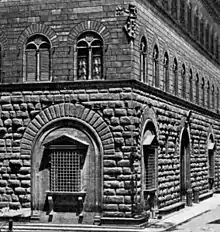Kneeling windows
Kneeling windows (Italian: Finestra inginocchiata) is a type of opening used from the fifteenth century, especially in the Tuscany area.


History
It is a monumental type used especially on the ground floor: the sill rests on supports protruding that resemble those of a kneeler's bench. Typical of the Mannerist and Tuscan Baroque periods, it is usually enclosed by a grille, framed and crowned by tympanum, sometimes with decorations, often zoomorphic: for example, the two supports are often carved as lion's paws and sometimes the space between them is decorated with a bas-relief.
The first kneeling window is traditionally the one in Palazzo Medici Riccardi in Florence, attributed to Michelangelo[1] It was made to occupy the large arch of a portal that once led to a family loggia.
Among the architects who indulged in the creation and decoration of kneeling windows were Bartolomeo Ammannati and Bernardo Buontalenti.
Notes
- A drawing by his hand remains in Casa Buonarroti and the invention is also mentioned by Vasari. See The Kneeling Windows of the Medici Palace, in P. Ruschi, Michelangelo architetto, Cinisello Balsamo 2011, pp. 55-57.